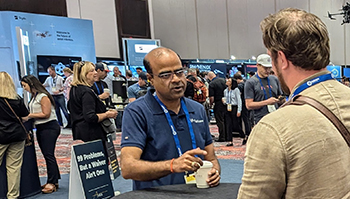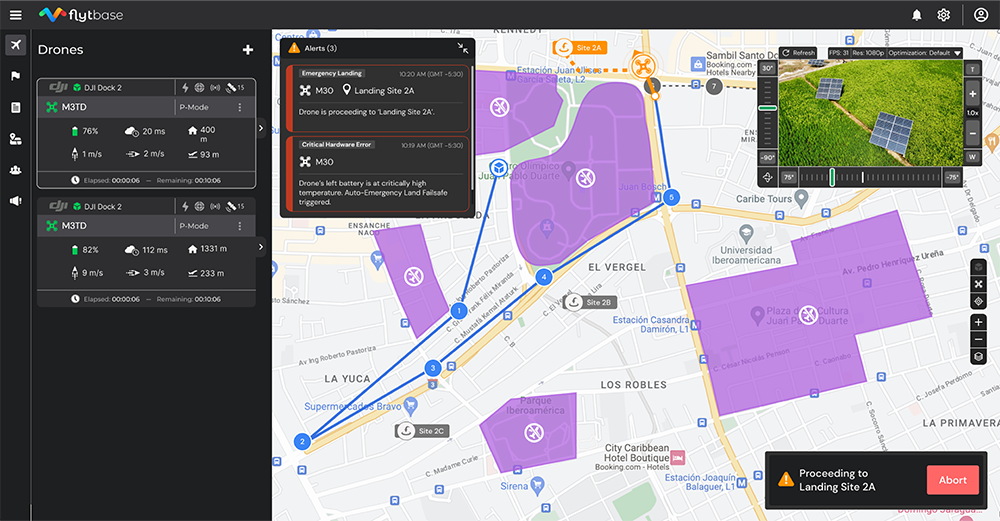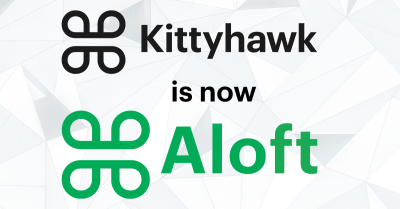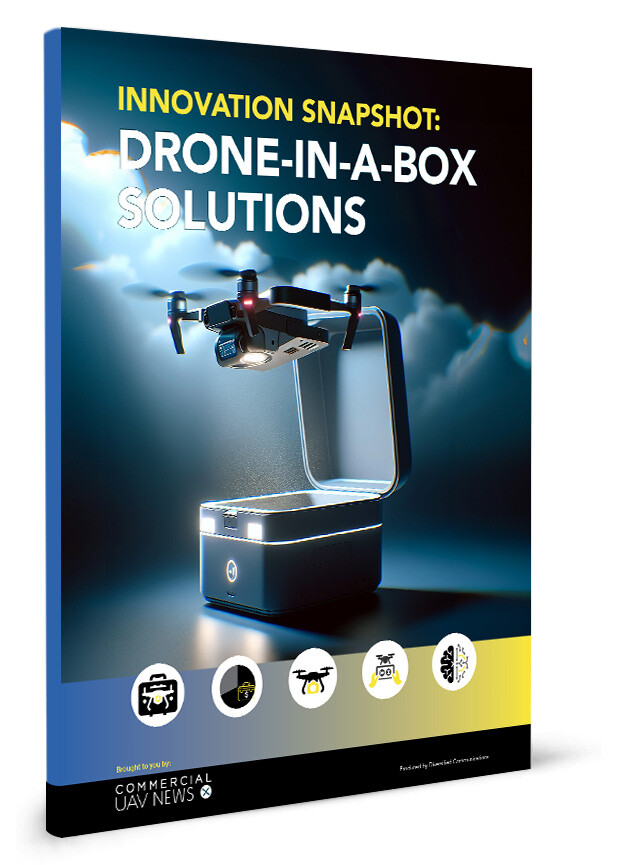Drones have been positioned as tools that can create efficiencies with dull, dirty and dangerous tasks, but most often, those efficiencies are specific to a given industry. However, automating repeatable and routine drone operations can create these efficiencies regardless of the application or industry, and that’s exactly what the Flytbase platform is designed to enable.
Dedicated to unlocking the airspace with fully autonomous drones, Flytbase’s vision to set standards for the seamless integration of drone hardware and apps is being pioneered by CEO Nitin Gupta, whose background as an aerospace engineer helped him understand how drones can solve problems that exist in enterprise ecosystems but also society as a whole. That vision has allowed him to put together a team of like-minded people who are focused on the type of collaboration that will take the drone industry into a new era.

Coming out of a strong showing at Commercial UAV Expo, we connected with Gupta for an in-depth interview to fully explore what sorts of opportunities can be opened up with drone autonomy. Hear what he has to say about how terms like “drone autonomy” continue to evolve, whether or not the drone industry is still in the “early adopter” phase, what the biggest misconceptions are in the industry, and much more.
Jeremiah Karpowicz: Your mission is to lead the way in enabling drone autonomy as the sky becomes increasingly busier with drones, but what does that mean in a practical sense? Could developments that we’re seeing right now with autonomous vehicles offer any insights for the future of the drone industry?
Nitin Gupta: When you think about autonomous cars, the challenges there are just so much more difficult because we have so many manually driven vehicles on the streets. The roads are already full of cars, which means you have to figure out how to make autonomous and non-autonomous vehicles cooperate and work with each other, which is a harder problem when compared to essentially starting fresh. And that’s what we can do with drones in the airspace.
That’s tied to our mission to enable this kind of autonomy, because right now, when you look at the skies, we hardly see any drones, which means accessibility is still a big problem. That’s where autonomy comes into play, and we have an advantage and an opportunity to make use of this space in a way that ultimately benefits everyone.
Those benefits for enterprise drone programs are what I wanted to focus on with you, as it sounds like they’re connected to the concept of drone operations at scale, which has long been tied to the hype and potential of drone technology. How have you been able to talk about and position these capabilities in a new way? What makes your platform different?
When we started building Flytbase, we had a choice; we could either go horizontal or vertical. And a decision to go horizontal has allowed us to support cloud-connected commercial drone applications at scale in a very different way.
Let me explain the difference though. When I say vertical, I mean we could have selected a particular industry that we wanted to focus on. That’s an industry like agriculture, just as an example. Going vertical in that industry would mean building hardware and software solutions that support solving challenges across that entire industry. It’s an approach that we saw many of our peers take over the past decade, where they’d build these monoliths (proprietary hardware, software) focused on a specific type of user.
However, at FlytBase, we made a strategic decision to instead go horizontal, which meant that rather than focusing on one industry vertical, we’d instead create a product that offers common technical abilities that could be leveraged to power many of these vertical solutions. Our product is designed to work across applications and provide a way for drones to scale and solve the problem of autonomy that needs to be solved for several applications, across sectors. So rather than develop the application layers ourselves, we committed to working with partners to provide them with a platform that can do so much more for their customers.
The easiest way to say it is that we’re the “glue” that connects systems and solutions to enable autonomy that would otherwise be very difficult to perform. We help put together complete solutions that solve problems. And those problems can be anything from an inspection to a survey, in industries that range from construction to public safety. This approach allows our integration partners and customers to select the right components, such as, hardware, data processing, safety systems, and other enterprise systems, and bring them all together using FlytBase to drive efficiencies and a positive ROI.

That glue metaphor is powerful because we’ve seen so many drone systems and solutions positioned as the “everything” product that usually ends up being so much less than promised.
That’s why we made the choice to work with system integrators and, for the most part, not directly with end users, because end users need something that is completely functional and working out of the box.
You can think of us like you might think of a tool like Salesforce. For CRM applications, Salesforce is one of the most well-known and powerful platforms, and it’s a great product. But at the same time, when you need to implement Salesforce for an organization that is ready to use it, you typically would involve an implementation agency or a system integrator that can customize Salesforce for your organization. There aren’t many people using Salesforce out of the box, because if you do, you’re just not getting the most out of the solution.
For Flytbase, getting the most out of a drone solution comes down to enabling autonomy, but how do you define "drone autonomy" to anyone who isn't overly familiar with the technology or industry? Has that definition changed at all over the past few years?
Autonomy is a term that is always changing because it’s always evolving in terms of capability and understanding.
That’s not specific to the drone industry though, which you can see with a term like “automobile.” The term is derived from words that mean “self” and “moving,” because when cars were invented, it significantly reduced the human effort that was required to go from place A to place B. Based on the expectations around transportation and technology at the time, these new inventions were “autonomous.” However, the term “autonomous cars” has a very different connotation today.
That’s somewhat incredible to think about when we’re talking about vehicles that needed to be manually driven and multiple people needed to be involved in their operation in a big way.
Yes, but that proves how and why the term continues to change. What happens is that in every era, we’re trying to find ways to reduce human effort. And anything that does that is called “autonomy” for that age. The definition keeps evolving because we become used to what becomes established as a new baseline for autonomy in every generation.
With drones, we’ve had autonomous flights that require a remote and human being involved for the past few years, but now, we’re beginning to talk about autonomous drones where we remove that pilot from the loop entirely. Today, we can have somebody sitting in a remote control room and operating drones through the internet. That’s drone autonomy on a whole new level.
As we move forward, the numbers and capabilities will increase, to the point where a single operator will be managing operations with hundreds of drones, and then moving to even higher levels of autonomy that continue to change how we use the term.
What are some of the biggest misconceptions out there in terms of where things are and where they need to go with drone autonomy? Are those misconceptions more about this continual evolution of the concept, or the technical realities, or something else?
The biggest misconception is that drone autonomy means just one thing. Every application has a very different need in terms of what drone autonomy means and needs to be, which is why we made the choice to respect and work to address those variations and build the right drone autonomy solution for each application.
Trying to solve autonomy for every application in the same manner isn’t going to work, because you have to understand each application and think about autonomy in that specific context. That’s also why you have to design the platform in a way that can accommodate these different requirements for each application.
You got specific with one of those applications with the Future of Solar With Autonomous Drones & Data Analytics report that highlights how drone technology is very much part of the solar industry as a whole. Do you envision drones will be part of the future of other industries in similar ways?
Solar is a very good use case because what everyone is realizing is that not every application is ready for autonomy. That’s why it’s important to understand the use case and make a decision about whether the application is a good candidate for autonomy or not.
In order to get ROI from docking stations or autonomy, it’s very important to have very high repeatability. That’s something that you need to operate multiple times a day, or at least multiple times every week. It’s even better if you're operating in the same environment every day, so everything is very well-defined. There are certain markers that we now understand quite well, and when you have those, you have a very good candidate for autonomy. And that’s what we see with solar.
Similar markers are visible with DFR, security or the inspection of industrial assets, for example. Anytime you're flying over the same space, again and again, you’re going to have a good case for adoption.
Can you tell us about how identifying and creating this kind of value with drone autonomy was discussed at NestGen '24? What is the origin of that event and what were some of your biggest takeaways from it this year?
NestGen is a virtual, annual summit focused on drone autonomy that we started about three years ago. The idea was to bring together the larger community that is focused on drone autonomy. It’s a place where we can all come together to discuss ideas, share what we’re learning, talk about what we are doing, and find ways to work together.
Collaboration is a big focus at Flytbase, so we’re always trying to find ways to work together and harness the collective intelligence of the community. It’s how we’ve been able to solve some of the biggest challenges as an industry and find ways to move forward together.
One of the biggest takeaways this year was about how docking stations, or drone-in-a-box solutions, are going to play an important role in the future of drone automation. Without docking stations, you really don't have autonomy because you’ll always need a person to charge or swap the battery. Once you have a docking station in place, you can start adding more and more autonomy layers and make it more sophisticated to reduce human effort. The docking stations are the foundation that all of that is built on.
It’s an important baseline, and the technology itself has changed in a big way. A few years ago, I remember seeing those drone-in-a-box solutions on the floor of trade shows, and they were HUGE. And quite expensive.
Yes, not too long ago, you were looking at perhaps $200K for a single system. But today, we’re talking more along the lines of $10-15K, so the price has come down considerably. More importantly, the early systems were quite clunky and not very reliable, as is usually the case for any new technology. Fortunately, we as an industry have made significant progress in that direction, and today several hundreds of drone-in-a-box systems are operating reliably in the field.
What’s also different is that in those early days, the ecosystem for collaboration didn’t exist, so everybody had to work out integration challenges for themselves. They had to sort out the hardware, the software, and the cloud applications, most of which were based on how a single operator could use it. Now though, the ecosystem to support this process not only exists but is also growing, so we can collaborate and solve these problems much more efficiently.
Pulling back a bit, what do you think are some of the essential elements to further building out the drone industry as a whole?
Broadly speaking, when you think about the industry, there are two major components.
One is, of course, the technical bit of it; how do you technically enable autonomy? Or how do you technically build solutions that can scale while keeping everyone and everything safe?
And the second is the regulatory side of things, to make sure the regulators understand the technology and realize how to set up the right parameters to enable that scale and safety. What does it mean to work with the regulators to help evolve standards and regulations to make it easier to adopt this technology? Both sides have to work together to enable the growth of this industry.
What are you most looking forward to changing or coming together for the drone industry in 2024? How are you hoping to see any of those developments discussed and explored at events like Commercial UAV Expo?
Things are moving quite rapidly. Nobody could have imagined three years or four years ago that there would be so much interest in drone autonomy. I remember talking to customers and partners and telling them how we could connect their drone to the cloud, and more often than not, I got pushback on that because they just wanted to have the pilot take care of everything. That’s changed in a big way, and we get requests all the time about what it means to connect a drone to the cloud. It’s gradually becoming the standard way of using this technology.
At the same time, the “autonomy” segment of the drone industry has not crossed the chasm yet, and that’s what I’m looking forward to seeing happen very soon. We’re still in the period of early adopters, but everything is in a far better spot when you compare it to where we were three or four years ago.
Oh, that's interesting. So you're thinking we're still in the early adopter phase? I’ve seen drones placed in just about every position on that Gartner Hype Cycle chart, but you think there's still so much ahead of us?
Yes, absolutely. When it comes to drone autonomy, we are very much in the early adopter phase.
Take a look at how many drones today are operated with docks, which forms the foundation for drone autonomy, because no matter what you’re doing, you need to have a person in the loop with a drone being operated without a dock. Just a fraction of drones in operation today, probably not even 1%, are using drone docks, which shows you the headroom that we have for growth, and why we are still in the early adopter phase.
Wrapping things up, we talked about the distinctions between how service providers and end users can consider adoption, so let’s start on the end user side. What advice would you have for someone who is thinking about commercial drone applications at scale in their organization, but isn’t sure what it means to take the next step to enable them?
That they need to really look at the ROI from using docking stations, because both, their price and their capabilities, have changed considerably over the past year and a half. We touched on how incredibly expensive they were in the past, and were not very reliable either. If you conducted perhaps 100 flights from a docking station, maybe five or six of them would fail, where the door wouldn’t open, or the battery wouldn’t charge, or there was a problem during landing. Those sorts of failure rates are unacceptable for industrial deployments. Fortunately, all such technical issues have been eliminated with the technology that’s available now. We have a lot of case studies from early adopters who are now using these solutions day-in-and-day out without any technical glitches or problems.
That price and those capabilities prove that it’s possible for organizations to deploy these systems at scale, and that’s a recent development. The next piece, of course, is working with regulators so that it becomes much easier to get their approvals or permissions to operate at scale. But that’s also why I’d tell someone to get started and build a real sense of what’s possible with these docking stations because then we can together not only demonstrate value for specific use cases, but also help regulators build confidence in the technology.
And on the service provider side, how should service providers be talking about the ways they can support commercial drone applications at scale?
We have a strong thesis around specialization, and that’s a critical component in the success we’ve seen with many of our service provider partners.
We talked about how years ago, many drone solutions were designed to appeal to every type of user and vertical, and it was the same with service providers. Many wanted to be able to support applications in every sector, ranging from agriculture to construction to energy and more, with various types of service offerings that could be applied to each.
However, that prevented many from going as deep as they needed to go with their customers. And now, as the industry is scaling, we are realizing the power of specialization. Going forward, all of the verticals are going to become that much more specialized. Unless you focus and you go deep in a particular vertical, or provide a very specific type of horizontal service, you will lose out to your competitors who will go deep.
Every day, we are realizing how complex customer needs are with everything from dashboard displays to order of operations. Unless you have a deep understanding of the industry, it’s very difficult to provide a great solution. So I’d recommend service providers build their expertise and ability to help customers solve their specific problems in a way that can only come from a true commitment to that industry or application.















Comments